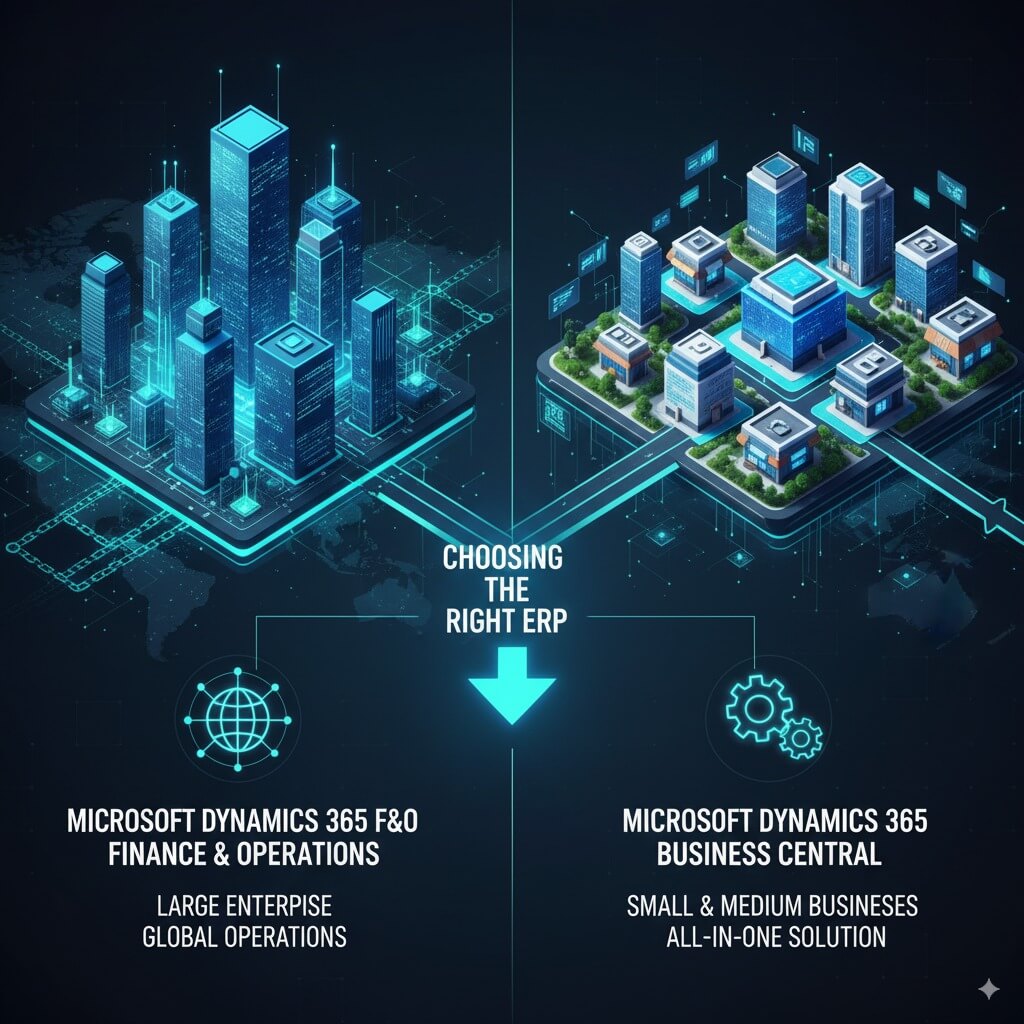Microsoft offers two powerful ERP (Enterprise Resource Planning) solutions under the Dynamics 365 suite: Finance & Operations (F&O) and Business Central (BC). While both are designed to streamline operations, they serve very different business needs.
If you’re evaluating ERP systems, understanding the differences between Dynamics 365 F&O and Business Central is essential to avoid costly mistakes and ensure the system aligns with your company’s size, complexity, and growth strategy.
What is Dynamics 365 Finance & Operations (F&O)?
Table of Contents
ToggleDynamics 365 F&O is a cloud-based ERP built for medium to large enterprises. It unifies finance, supply chain, and manufacturing operations into one intelligent system.
Best for: Enterprises with complex global operations.
Key strengths: Advanced finance, supply chain management, manufacturing, and compliance.
Scalability: Handles multi-company, multi-currency, multi-language environments.
Industries: Manufacturing, distribution, retail, logistics, and regulated industries.
What is Dynamics 365 Business Central (BC)?
Business Central is a comprehensive ERP for small to mid-sized businesses (SMBs). It combines finance, sales, purchasing, inventory, and project management in one system.
Best for: SMBs seeking an affordable, easy-to-implement ERP.
Key strengths: Core ERP functionality with user-friendly deployment.
Scalability: Supports growing businesses but is not designed for highly complex, global operations.
Industries: Retail, professional services, small manufacturers, wholesale trade.
Key Comparison: Dynamics 365 F&O vs Business CentralFeature / Aspect Dynamics 365 Business Central (BC) Dynamics 365 Finance & Operations (F&O) Target Audience Small to mid-sized businesses Medium to large enterprises with complex needs Deployment Cloud-first (simpler, faster implementation) Cloud-first (enterprise-level with hybrid options) Financial Management Core finance, accounting, and reporting Advanced finance, compliance, and global tax support Supply Chain Basic procurement & inventory control Advanced SCM, logistics, demand forecasting Manufacturing Light manufacturing functionality Full discrete, lean, and process manufacturing Scalability Regional growth Multi-country, multi-currency, multi-language Customization Easier, SMB-friendly extensions Deeper customization for enterprise requirements Integration Integrates with Microsoft 365 & Power Platform Integrates with full Microsoft ecosystem & advanced AI Cost Lower subscription/licensing costs Higher licensing and implementation costs Implementation Time Weeks to months Months to years (depending on complexity) Best Fit Companies seeking affordable, quick ERP Enterprises needing global, enterprise-grade ERP
Key Comparison: Dynamics 365 F&O vs Business Central
Feature / Aspect Dynamics 365 Business Central (BC) Dynamics 365 Finance & Operations (F&O) Target Audience Small to mid-sized businesses Medium to large enterprises with complex needs Deployment Cloud-first (simpler, faster implementation) Cloud-first (enterprise-level with hybrid options) Financial Management Core finance, accounting, and reporting Advanced finance, compliance, and global tax support Supply Chain Basic procurement & inventory control Advanced SCM, logistics, demand forecasting Manufacturing Light manufacturing functionality Full discrete, lean, and process manufacturing Scalability Regional growth Multi-country, multi-currency, multi-language Customization Easier, SMB-friendly extensions Deeper customization for enterprise requirements Integration Integrates with Microsoft 365 & Power Platform Integrates with full Microsoft ecosystem & advanced AI Cost Lower subscription/licensing costs Higher licensing and implementation costs Implementation Time Weeks to months Months to years (depending on complexity) Best Fit Companies seeking affordable, quick ERP Enterprises needing global, enterprise-grade ERP When to Choose Business Central
You’re a small or mid-sized business looking for a cost-effective ERP.
Your operations are regional or single-country, not global.
You need fast implementation with minimal complexity.
You want an ERP tightly integrated with Microsoft 365 tools (Excel, Outlook, Teams).
When to Choose Finance & Operations (F&O)
You’re a large enterprise with multiple subsidiaries or locations worldwide.
Your business requires complex manufacturing and supply chain management.
You operate in regulated industries that demand compliance and audit-ready systems.
You need scalability to manage thousands of users, currencies, and transactions daily.
Common Ground: What Both Systems Share
Despite their differences, F&O and BC share Microsoft’s core advantages:
Cloud-based flexibility on Azure.
Integration with Power BI, Power Platform, and Microsoft 365.
Strong security, scalability, and updates from Microsoft.
A user-friendly interface with role-based dashboards.
Conclusion: Business Central vs Finance & Operations
Business Central is ideal for growing SMBs that want to move beyond spreadsheets or entry-level accounting systems into a professional ERP.
Finance & Operations is the solution for large, complex enterprises seeking a global, enterprise-grade ERP to unify finance, supply chain, and manufacturing.
Choosing between the two depends on your company’s size, complexity, growth strategy, and industry requirements.
With the right Microsoft partner (like Trax Group), your ERP choice becomes not just a software implementation but a foundation for digital transformation.







No comment